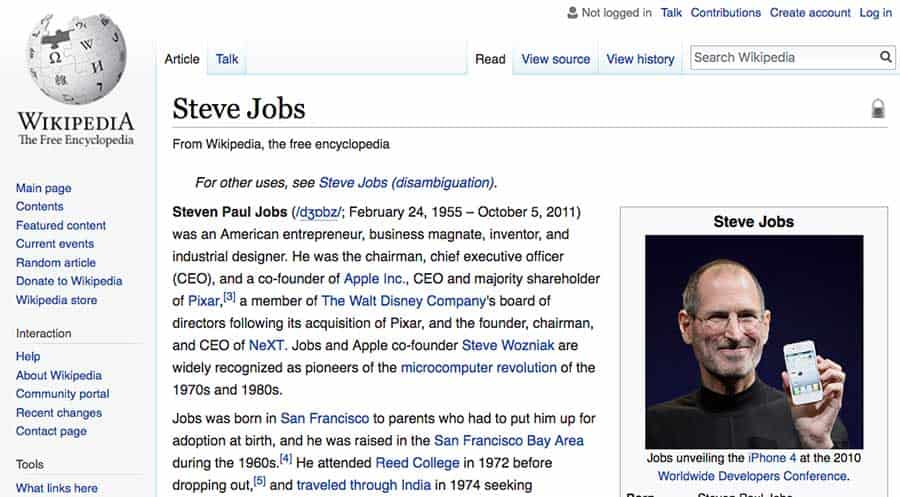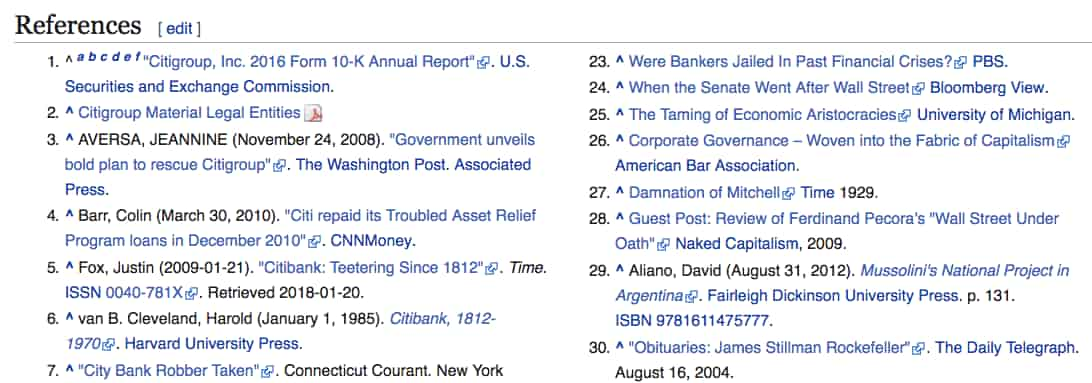The Reverse Wikipedia Strategy of Reputation Management Strategy
What is a Reverse Wikipedia Strategy?
The Reverse Wikipedia Strategy is a framework to improve a brand’s online content by imagining what an ideal Wikipedia page may look like in a year or more. Within a family of strategies used by Reputation X, it’s an exercise for strategists and content creators to think about the best possible branded content.
Imagine the elements of a Wikipedia page. Your Reverse Wikipedia Strategy must be tailor-made to create premiere content that will adequately portray your vision. For example, a good Wikipedia page will have:
- Headings and sections: Headings introduce sections and clarify what the content is about.
- References: References are critical to establishing notability on Wikipedia. It is not advised to add anything to Wikipedia without strong references. If there are no existing references, imagine what types of references would support the Wikipedia page if it were real.
- Infoboxes: The infobox is the factual information found at the top and upper right, of a Wikipedia article. It’s often the first place people look when researching a brand online.
- Article content: Add sections that are notable and relevant to Wikipedia articles.
This forms the basis for content that withstands the smell test. The end result is a highly relevant content plan free of web spam.
Sections
- Benefits of a Reverse Wikipedia Strategy
- What is the Reverse Wikipedia Strategy?
- How does this help with ORM strategy?
- How to measure the success of a Reverse Wikipedia Strategy
Benefits
The benefits of a Reverse Wikipedia Strategy include:
- A clear blueprint for the tale search results will tell
- A shared vision of the online brand for all stakeholders
- A list of publications to target in order to fulfill the brand vision
- A spam-free content plan that is also highly relevant and impactful
What is the Reverse Wikipedia Strategy?
The Reverse Wikipedia Strategy has four parts. Each part is associated with an aspect of a real Wikipedia page:
- Summary of the Brand Story
- Sections in the page supporting the story
- An outline of the content within each section
- References that support the story
1. Summary
Most Wikipedia pages start with a summary or background. For example, look at Steve Jobs’ page here. The summary is an overview of the article. The story of the brand, told in encyclopedic fashion, should be told here. Later sections will support the most relevant themes contained in the summary.
2. Sections
The sections discuss important aspects of the brand. In the Steve Jobs example, sections include:
- Childhood
- High school
- College
- Pre-Apple
- Next Computer
- And others
These are all important aspects of the overall story. When executing a Reverse Wikipedia ORM Strategy, the sections are important because they will later inform the content to either be created or cause to be created. They are the sub-themes within the brand story.
3. Content within sections
Each section dives deeper into the topic covered. Details and references with links to other Wikipedia pages or third-party sites support the claims within.
4. References / Citations
Every Wikipedia page is supported by references as to its notability. References must be trustworthy and non-promotional. References are often called “citations”.
References become the milestones a brand’s reputation campaign executes. Put another way – the references in the imaginary Wiki page are used as a guide for outreach that PR specialists can use to build a positive online presence for the brand.
Similar people, companies, products, or services should already have a Wikipedia page. At the bottom of the page are citations/references. A good way of finding future publications for the RWOS is to borrow them from existing Wikipedia pages of similar brands.
How does this help with ORM strategy?
At Reputation X, we use the RWOS for online reputation management (ORM). Online reputation management can improve or even re-engineer how a brand is seen online. By imagining, and even developing a future Wikipedia page, our Strategists are forced to think about the online content that would best support the brand in the long run.
The content must meet reliability guidelines and withstand the scrutiny of Wikipedia editors. It ensures a high-quality online brand that fits the overall theme created during a reputation management campaign.
The whole team envisions the future brand
The RWOS provides a vision of the brand the entire team can get behind. It uses an imaginary/future Wikipedia page as a vehicle for understanding and envisioning what the brand could be, as well as how that vision can be reflected online. It helps everyone get on the same page.
When completed, the RWOS provides:
- The future story of the brand
- A list of media targets that will support the story
- An outline for a future Wikipedia page (optional)
Everyone focused on the best story
When improving or changing the online reputation of a brand, one of the first questions to be asked is, “What will the future story be?”.
During a reputation repair campaign, the brand manager usually wants negative online content to be magically gone. But it’s important to replace unflattering online content with something better. That’s where envisioning a better story in the form of an idealized (but reasonable) Wikipedia page comes in.
Reputation content support
Wikipedia contains encyclopedic pages that cover a topic comprehensively and references relevant and reliable source material. It’s designed to be helpful, clear, and to satisfy the reader’s inquiries in a non-promotional way.
The story a Wikipedia page tells must adhere to Wikipedia’s policies. That means that claims made must reference citations.
For a brand reputation strategist, this means reference articles must verify the claims made on the page from reliable third parties. The references must be true, verifiable, and credible. The most credible third-party content comes from trusted publications.
For example, a Forbes article would be a more credible reference for the Wikipedia page of a financial services firm than someone’s personal blog would be.
For content creators, planning to support the future story of the brand where the supporting information appears is as important as the information itself. A media plan that fulfills the vision of a Reverse Wikipedia ORM Strategy (RWOS) for the aforementioned firm might include publications like this:
- Forbes.com
- MotleyFool.com
- Bloomberg.com
- Crunchbase.com
- Highbeam.com
- ABCNews.com
- WallStreetJournal.com
- CNNMoney.com
Tip: Use your brand name in the headline
Want your content to perform better in search results? Try to get your brand name into the headline of articles written about it. It’s tough to do, but it’s worth it when you can.
One does not simply write a Wikipedia page
To badly paraphrase Boromir from The Lord of the Rings, “One does not simply write a Wikipedia page.” The RWOS doesn’t always end as a Wikipedia page because that’s not the point. The point is to visualize and structure future content that supports a positive brand image.
Here is a summary of how the RWOS is created:
- Develop a Wikipedia page and its story, but don’t publish
- Note the ideal references the future page would have
- Develop stories and supporting information for each publication
- Start building relationships to pitch stories and get them on the editorial calendars
At this point, there is no Wikipedia page. But chances are the stories that support the future brand vision have begun to appear online and in more visible places. A Wikipedia page is an option now.
Was it successful?
You’ll know the content seeding process has been done well if the content you created begins to appear on an existing Wikipedia page, is shared naturally, and/or linked to.
Using the financial services firm example, the successful placement of a Forbes article by a contributor or staff writer that is relevant to the brand might be added naturally to an existing Wikipedia page. If this happens organically (it’s not done by you), then you know it’s working. But even if it doesn’t, the content is likely to show up in search results.
Next steps
At this point, you may influence the creation of a Wikipedia page (or edit an existing one) using that information. Perhaps someone else will. Whether a real page ever comes to light isn’t as important as the fact that the RWOS has helped generate a cogent, true, and reputationally positive online content environment.
At this point, boosting positive brand reputation through the use of search engine optimization and other online marketing tactics will truly bear fruit – transforming the way a brand is perceived online.
Reverse Wikipedia Strategy FAQs
What is the Reverse Wikipedia Strategy?
The Reverse Wikipedia Strategy is a framework to improve a brand’s online content by imagining what an ideal Wikipedia page may look like in a year or more. It provides a clear picture for strategists and content creators to think about the best possible branded content.
What are the benefits of a Reverse Wikipedia Strategy?
The benefits of a Reverse Wikipedia Strategy include a clear blueprint for the tale search results will tell, a shared vision of the online brand for all stakeholders, a list of publications to target in order to fulfill the brand vision, and a spam-free content plan.
What are the components of the Reverse Wikipedia Strategy?
The Reverse Wikipedia Strategy has four parts. 1. Summary of the brand story. 2. Sections in the page supporting the story. 3. An outline of the content within each section. 4. References that support the story.
Does the Reverse Wikipedia Strategy result in the creation of a Wikipedia page?
Not always. The articles and stories that are created as a result of the Reverse Wikipedia Strategy will build notability in search results. This will open up the option to create a Wikipedia page when the timing is right.
About the author
Kent Campbell is the chief strategist for Reputation X, an award-winning online reputation management agency based in California. Kent has over 15 years of experience with online reputation management, Wikipedia editing, review management, and strategy. Kent has helped celebrities, leaders, executives, and marketing professionals improve the way they are seen online. Kent writes about reputation, SEO, Wikipedia, and PR-related topics, and is an expert witness for reputation-related legal matters.
–
Tags: Online Reputation Repair, Reputation Management, Reputation Protection.



